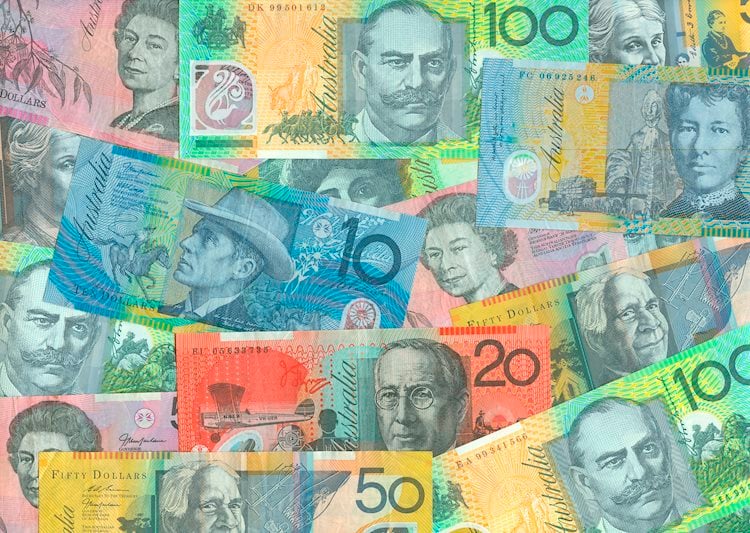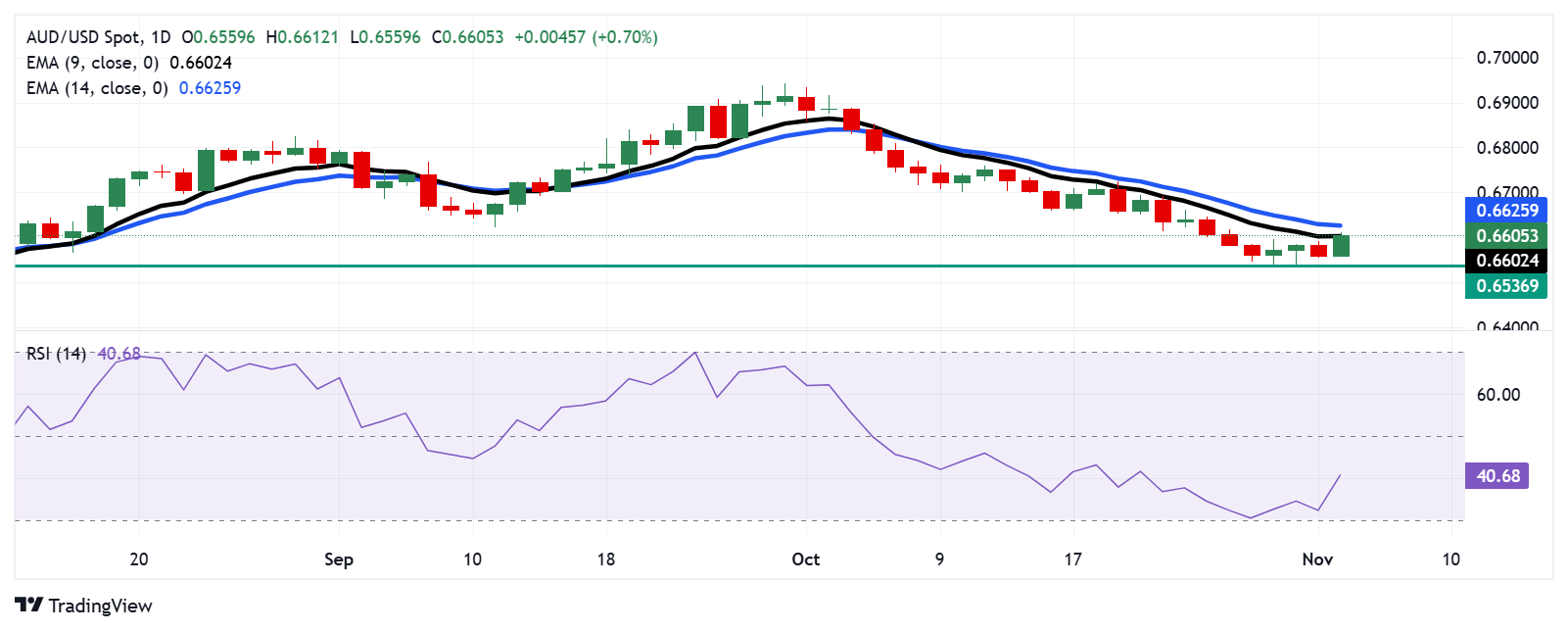Products You May Like
- The Australian Dollar appreciated as the TD-MI Inflation Gauge rose by 0.3% MoM in October, up from previous 0.1% increase.
- The Reserve Bank of Australia is widely expected to maintain the cash rate at 4.35% on Tuesday.
- The US Dollar may receive support from safe-haven flow amid uncertainty surrounding the US presidential election results on November 5.
The Australian Dollar (AUD) strengthens after the release of the Melbourne Institute’s Inflation Gauge data on Monday. The Reserve Bank of Australia (RBA) is expected to maintain the cash rate at 4.35% during Tuesday’s policy meeting, as underlying inflation, reflected in the trimmed mean, remains high. This anticipated hawkish stance from the RBA continues to support the Aussie Dollar, bolstering the AUD/USD pair.
The TD-MI Inflation Gauge rose by 0.3% month-over-month in October, up from a 0.1% increase in the prior month, marking the highest reading since July and preceding the RBA’s November policy meeting. Annually, the gauge climbed by 3.0%, compared to the previous 2.6% reading.
The US Dollar (USD) weakens following Friday’s release of weaker-than-expected US October Nonfarm Payrolls (NFP) data. However, uncertainty surrounding the outcome of the US presidential election on November 5 could prompt safe-haven flows, which may support the Greenback.
Traders are also focusing on the upcoming US Federal Reserve (Fed) policy decision, with expectations of a modest 25 basis point rate cut this week. The CME FedWatch Tool currently indicates a 99.6% probability of a quarter-point rate cut by the Fed in November.
Daily Digest Market Movers: Australian Dollar rises following release of key domestic data
- ANZ Australia Job Advertisements increased by 0.3% month-over-month in October, a notable slowdown from the upwardly revised 2.3% gain in September. Despite the weaker growth, this marks the second consecutive month of increases.
- On Sunday, China’s Commerce Minister Wang Wentao met with Australia’s Trade Minister Don Farrell. China expressed hopes that Australia will continue enhancing its business environment and ensure fair and equitable treatment for Chinese companies.
- The final New York Times/Siena College poll, reported by Reuters, shows Vice President Kamala Harris with slight leads in Nevada, North Carolina, and Wisconsin, while former President Donald Trump holds a narrow edge in Arizona. The candidates are in close contests in Michigan, Georgia, and Pennsylvania. Conducted from October 24 to November 2, the poll indicated that all matchups in seven battleground states fall within a 3.5% margin of error.
- US Bureau of Labor Statistics (BLS) indicated that October’s Nonfarm Payrolls increased by only 12,000, following a revised September gain of 223,000 (down from 254,000), which fell well short of market expectations of 113,000. Meanwhile, the Unemployment Rate remained steady at 4.1% in October, matching the consensus forecast.
- Australia’s Producer Price Index rose by 0.9% quarter-on-quarter in Q3, following a 1.0% increase in the prior period and surpassing market forecasts of a 0.7% rise. This marks the 17th consecutive period of producer inflation. On an annual basis, the PPI growth slowed to 3.9% in Q3, down from the previous quarter’s 4.8% increase.
- China’s Caixin Manufacturing Purchasing Managers Index (PMI) increased to 50.3 in October, up from 49.3 in September, surpassing market expectations of 49.7. As China is a key trade partner for Australia, shifts in the Chinese economy could significantly influence Australian markets.
- The US Personal Consumption Expenditures (PCE) Price Index indicated that core inflation rose by 2.7% year-over-year in September. Additionally, Initial Jobless Claims fell to a five-month low of 216,000 for the week ending October 25, signaling a resilient labor market and reducing expectations for imminent rate cuts by the Federal Reserve (Fed).
- The seasonally adjusted Australian Retail Sales rose by 0.1% month-over-month in September, falling short of the expected 0.3% and significantly down from the 0.7% growth seen in the previous month. On a quarterly basis, Retail Sales increased by 0.5% in Q3, rebounding from a 0.3% decline in the prior quarter.
Technical Analysis: Australian Dollar tests 0.6600, nine-day EMA
AUD/USD trades near 0.6600 on Monday. The daily chart signals a possible softening of the bearish bias as the pair tests the nine-day Exponential Moving Average (EMA). However, the 14-day Relative Strength Index (RSI) remains below the 50 level; a rise above 50 would reflect a shift in momentum from bearish to bullish.
On the resistance side, AUD/USD faces the nine-day EMA at 0.6602, with the next resistance at the 14-day EMA at 0.6625. A break above these levels could strengthen the pair, potentially targeting the psychological level of 0.6700.
In terms of support, AUD/USD may find immediate support at the three-month low of 0.6536. A break below this level could push the pair toward the key psychological level of 0.6500.
AUD/USD: Daily Chart
Australian Dollar PRICE Today
The table below shows the percentage change of Australian Dollar (AUD) against listed major currencies today. Australian Dollar was the strongest against the US Dollar.
| USD | EUR | GBP | JPY | CAD | AUD | NZD | CHF | |
|---|---|---|---|---|---|---|---|---|
| USD | -0.54% | -0.46% | -0.23% | -0.13% | -0.67% | -0.29% | -0.30% | |
| EUR | 0.54% | 0.04% | -0.10% | 0.00% | 0.17% | -0.16% | -0.16% | |
| GBP | 0.46% | -0.04% | -0.39% | -0.03% | 0.14% | -0.19% | -0.20% | |
| JPY | 0.23% | 0.10% | 0.39% | 0.09% | 0.10% | 0.13% | 0.22% | |
| CAD | 0.13% | -0.01% | 0.03% | -0.09% | -0.33% | -0.18% | -0.17% | |
| AUD | 0.67% | -0.17% | -0.14% | -0.10% | 0.33% | -0.33% | -0.33% | |
| NZD | 0.29% | 0.16% | 0.19% | -0.13% | 0.18% | 0.33% | -0.01% | |
| CHF | 0.30% | 0.16% | 0.20% | -0.22% | 0.17% | 0.33% | 0.00% |
The heat map shows percentage changes of major currencies against each other. The base currency is picked from the left column, while the quote currency is picked from the top row. For example, if you pick the Australian Dollar from the left column and move along the horizontal line to the US Dollar, the percentage change displayed in the box will represent AUD (base)/USD (quote).
Australian Dollar FAQs
One of the most significant factors for the Australian Dollar (AUD) is the level of interest rates set by the Reserve Bank of Australia (RBA). Because Australia is a resource-rich country another key driver is the price of its biggest export, Iron Ore. The health of the Chinese economy, its largest trading partner, is a factor, as well as inflation in Australia, its growth rate and Trade Balance. Market sentiment – whether investors are taking on more risky assets (risk-on) or seeking safe-havens (risk-off) – is also a factor, with risk-on positive for AUD.
The Reserve Bank of Australia (RBA) influences the Australian Dollar (AUD) by setting the level of interest rates that Australian banks can lend to each other. This influences the level of interest rates in the economy as a whole. The main goal of the RBA is to maintain a stable inflation rate of 2-3% by adjusting interest rates up or down. Relatively high interest rates compared to other major central banks support the AUD, and the opposite for relatively low. The RBA can also use quantitative easing and tightening to influence credit conditions, with the former AUD-negative and the latter AUD-positive.
China is Australia’s largest trading partner so the health of the Chinese economy is a major influence on the value of the Australian Dollar (AUD). When the Chinese economy is doing well it purchases more raw materials, goods and services from Australia, lifting demand for the AUD, and pushing up its value. The opposite is the case when the Chinese economy is not growing as fast as expected. Positive or negative surprises in Chinese growth data, therefore, often have a direct impact on the Australian Dollar and its pairs.
Iron Ore is Australia’s largest export, accounting for $118 billion a year according to data from 2021, with China as its primary destination. The price of Iron Ore, therefore, can be a driver of the Australian Dollar. Generally, if the price of Iron Ore rises, AUD also goes up, as aggregate demand for the currency increases. The opposite is the case if the price of Iron Ore falls. Higher Iron Ore prices also tend to result in a greater likelihood of a positive Trade Balance for Australia, which is also positive of the AUD.
The Trade Balance, which is the difference between what a country earns from its exports versus what it pays for its imports, is another factor that can influence the value of the Australian Dollar. If Australia produces highly sought after exports, then its currency will gain in value purely from the surplus demand created from foreign buyers seeking to purchase its exports versus what it spends to purchase imports. Therefore, a positive net Trade Balance strengthens the AUD, with the opposite effect if the Trade Balance is negative.

